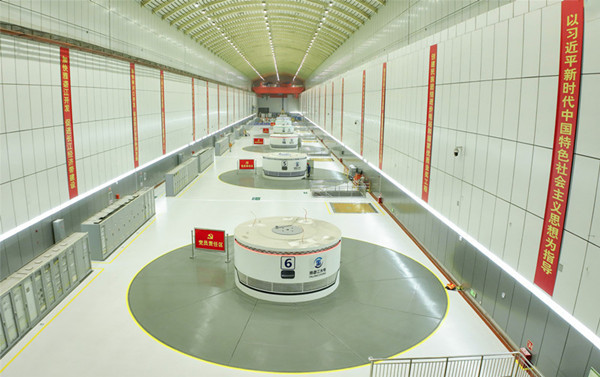The Lianghekou hydropower plant over the Yalong River in Southwest China's Sichuan Province started full service as its last generator unit passed 72-hour trial operation on March 18.
Located in the Tibetan Autonomous Prefecture of Garze County, it has an average altitude of 3,000 meters, the highest of its kind in China.
Invested and built by State Development & Investment Corp., Ltd. (SDIC), the project has a designed reservoir storage capacity of 10.8 billion cubic meters and a total installed capacity of 3 million kilowatts, and can generate over 11 billion kilowatt-hours of power annually.

A view inside the Lianghekou hydropower plant in the Tibetan Autonomous Prefecture of Garze, Sichuan Province [Photo/sasac.gov.cn]
A key national and provincial project, the hydropower plant is a main player in optimizing energy supply side reform in the country's strategy for large-scale development of western China.
The new plant enables stable and high-quality wind and solar power generated in the Yalong River basin, the country's third-largest hydropower base, to be exported to other regions where it will help ease imbalanced power generation in Sichuan and promote high-quality development of the Yangtze Economic Belt and the Chengdu-Chongqing economic circle.

A bird's-eye view of the Yalong River basin, the country's third-largest hydropower base [Photo/sasac.gov.cn]
It's worth noting that development and construction of the Lianghekou hydropower plant is a model of China's major projects under cooperation of central state-owned enterprises and local governments. Construction of the project took 17 years, drove Sichuan's GDP growth of over 100 billion yuan ($15.73 billion) and provided jobs for more than 20,000 people annually.
Yalong River Hydropower Development Company, Ltd, SDIC's subsidiary, also directly invested 12.1 billion yuan in infrastructure upgrading in Garze, benefiting 82 administrative villages of four counties.
Operation of the plant will increase local tax by over 600 million yuan, boosting local economic and social development and promoting rural revitalization.
(Executive editor: Niu Yilin)